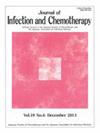某社区医院发生15A血清型(非疫苗血清型)耐多药肺炎链球菌院内疫情。
IF 1.5
4区 医学
Q3 INFECTIOUS DISEASES
引用次数: 0
摘要
耐多药肺炎链球菌(MDRSP)显示出对β-内酰胺类、大环内酯类和氟喹诺酮类药物的耐药性,这给临床带来了重大挑战,随着肺炎球菌结合疫苗的引入,15A和35B等非疫苗血清型(NVT)的流行率不断上升。在这里,我们报告了从一家社区医院的四名患者中分离出的血清型15A耐多药耐药sp暴发。院内暴发发生在一个急症病房,影响了4名未接种疫苗的老年患者(62-91岁)。所有分离株血清型均为15A型,对β-内酰胺类、氟喹诺酮类和大环内酯类耐药。分离株属于序列型(ST) 292的单位点变异,在青霉素结合蛋白(PBPs; PBP1a, 2b和2x)的转肽酶结构域显示氨基酸改变,并且突变导致gyrA, parC和parE的喹诺酮类药物耐药区域的氨基酸改变。此外,它们同时携带ermB和mefA/E基因。这些发现表明克隆爆发。回顾性分析提示可能与频繁吸痰、管饲、低体重指数和住院时间过长有关。MDRSP可能通过在患者附近工作的卫生保健工作者传播。通过实施接触预防措施、聚集和使用封闭吸引系统,疫情在24天内得到控制。本报告描述了日本首次记录的MDRSP ST292谱系的医院暴发,强调了几个要点:卫生保健机构中出现的多药耐药NVT,基本感染控制措施在预防方面的有效性,以及血清分型对了解致病性和耐药模式的重要性。本文章由计算机程序翻译,如有差异,请以英文原文为准。
Nosocomial outbreak of multidrug-resistant Streptococcus pneumoniae serotype 15A (non-vaccine serotype) in a community hospital
Multidrug-resistant Streptococcus pneumoniae (MDRSP) showing resistance to β-lactams, macrolides, and fluoroquinolones poses a significant clinical challenge, with increasing prevalence of non-vaccine serotypes (NVT) such as 15A and 35B following the introduction of pneumococcal conjugate vaccines. Here, we report an outbreak of serotype 15A MDRSP isolated from four patients at a community hospital. A nosocomial outbreak occurred in an acute care ward and affected four unvaccinated elderly patients (aged 62–91 years). All isolates were identified as serotype 15A and showed resistance to β-lactams, fluoroquinolones, and macrolides. The isolates belonged to a single-locus variant of sequence type (ST) 292 and showed amino acid alterations in the transpeptidase domains of penicillin-binding proteins (PBPs; PBP1a, 2b, and 2x), and mutations causing amino acid changes in the quinolone resistance–determining regions of gyrA, parC, and parE. Additionally, they harbored both ermB and mefA/E genes. These findings indicate a clonal outbreak. A retrospective analysis suggests possible associations with frequent sputum suctioning, tube feeding, low body mass index, and prolonged hospitalization. MDRSP likely spread via healthcare workers working within the vicinity of the patients. The outbreak was contained within 24 days by the implementation of contact precautions, cohorting, and the use of closed suction systems. This report describes the first documented nosocomial outbreak of MDRSP ST292 lineage in Japan, highlighting several important points: the emergence of multidrug-resistant NVT in healthcare settings, the effectiveness of basic infection control measures in prevention, and the importance of serotyping in understanding pathogenicity and resistance patterns.
求助全文
通过发布文献求助,成功后即可免费获取论文全文。
去求助
来源期刊

Journal of Infection and Chemotherapy
INFECTIOUS DISEASES-PHARMACOLOGY & PHARMACY
CiteScore
4.10
自引率
4.50%
发文量
303
审稿时长
47 days
期刊介绍:
The Journal of Infection and Chemotherapy (JIC) — official journal of the Japanese Society of Chemotherapy and The Japanese Association for Infectious Diseases — welcomes original papers, laboratory or clinical, as well as case reports, notes, committee reports, surveillance and guidelines from all parts of the world on all aspects of chemotherapy, covering the pathogenesis, diagnosis, treatment, and control of infection, including treatment with anticancer drugs. Experimental studies on animal models and pharmacokinetics, and reports on epidemiology and clinical trials are particularly welcome.
 求助内容:
求助内容: 应助结果提醒方式:
应助结果提醒方式:


